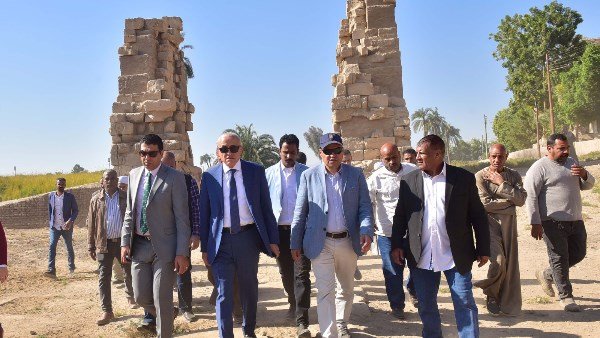Engineer Abdel Muttalib, Governor of Luxor, inspected the building of the Governor of Luxor, the Temple of Toud, to discuss ways to develop the temple and the surrounding area, in the presence of Dr. Hisham Abu Zeid, Deputy Governor of Luxor, Dr. Abdel Ghaffar Wagdy, Director General of Egyptian, Greek and Roman Antiquities in Luxor, Engineer Abdel Masih Nabil, Director of Urban Planning, and a number of restorers. Antiquities.
The Governor of Luxor listened to an explanation about the history of the temple, which is considered one of the oldest temples in Luxor Governorate.
The Governor of Luxor continued his tour by inspecting the Temple of Montu in Madamud Al-Agouz, and listened to the most important obstacles to the development of the temple, represented by groundwater. He also listened to the citizens’ problems, which are represented by the lack of access to sanitation services to the area.
For his part, Amara confirmed that work is underway on the Madamud Al-Agouz sanitation project, announcing the actual operation of the sanitation service in Madamud Al-Agouz at the end of next May, which will serve the people of the region and also contribute to implementing the development work of the Montu Temple and the surrounding area.
During his tour, the Governor of Luxor listened to the complaints of some citizens regarding the covering of one of the wells as it constituted an imminent danger to the children of the region. He immediately directed “Amara”, in coordination between the Zinnia City Council and the National Authority for Drinking Water and Sanitation, to cover this well.
Residents also called for the increase of lighting poles in the area to reduce traffic accidents and improve visibility.
The Governor of Luxor explained that mechanisms for completing the implementation of the development work of the ancient Tud Temple in Luxor and the surrounding area will be discussed, in coordination with the Ministry of Tourism and Antiquities, led by Sherif Fathi, Minister of Tourism and Antiquities, by identifying the actual needs for its development.
He pointed out that the work to develop archaeological areas aims primarily to preserve the history and civilization of our ancestors so that it remains a beacon for the whole world, and this development also aims to attract more tourists from various parts of the world.











